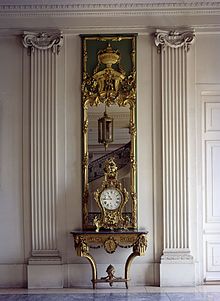House to the cherry orchard

The Haus zum Kirschgarten is a city palace on Elisabethenstrasse in Basel , Switzerland .
history
The Haus zum Kirschgarten was built between 1775 and 1780 as a residential and commercial building by the 24-year-old architect Johann Ulrich Büchel (1753–1792) for the then 27-year-old Basel silk ribbon manufacturer Johann Rudolf Burckhardt . Burckhardt did not use the house for long; In 1797 he retired to his Ernthalde estate in Gelterkinden . His son Jean Louis Burckhardt spent his childhood here.
The house in the cherry orchard was then initially acquired by the officer and banker Jean Merian-Forcart (1770–1856) from the older Merian line ; from this it went to the banker Johann Jakob Bischoff-Kestner (1797-1865), a grand son-in-law of Charlotte Kestner (he had married her granddaughter Caroline). The house was sold in 1864 and 1912 - in the period in between, Johann Jakob Im Hof lived in the city palace with his second wife Amalia Rüsch, née Jakob (1831–1911) - and in 1917 it became the property of the National Bank and the state through an exchange. In the courtyard under the exemplary model was in the Cherry Grove St. Jacob monument of Ferdinand Schlöth erected. While the four warrior figures were transferred to the building department in Falkensteinerhof on Münsterplatz after Im Hof's death, the figure of Helvetia remained in the cherry orchard until the 1940s. After the loss of the Segerhof, which served as a residential museum until 1934, the Historical Museum was able to take over the Haus zum Kirschgarten in 1951.
The Haus zum Kirschgarten, which impresses above all with its filigree sandstone facade , the generous carriage passage through the main portal and the imposing staircase, has an unusually high standard of representation by Basel standards. It reflects the status of its builder; Burckhardt was one of the wealthiest and most influential Basel residents of his time.
The architecture and the spatial plan, including an unfinished friendship temple in an annex on the main floor, reveal influences of the Masonic movement . The Haus zum Kirschgarten symbolically carries the idealistic claim of the Freemasons - building the Temple of Humanity. It justifies its “larger style”, which was criticized by contemporaries, and enabled its client to make the appropriate appearance.
museum
Over the years the house changed hands several times. It has been open to the public as part of the Basel Historical Museum since 1951 . The permanent exhibitions in the Haus zum Kirschgarten are mainly dedicated to the living culture of Basel in the 18th and 19th centuries. Special collections of international importance can also be seen here, such as the watch collections of Leni and Carl Nathan-Rupp and Eugen Gschwind as well as scientific instruments, Basel silver and toys.
literature
- Burkard by Roda, Benno Schubiger, Lukas Hartmann a. a .: The Zum Kirschgarten house and the beginnings of classicism in Basel. In: Longing for antiquity. Historical Museum Basel. Publication accompanying the exhibition 1995–1996.
- Burkard von Roda : The house to the cherry orchard in Basel. Masonic symbolism to legitimize the “greater style” of town house architecture. In: Art + Architecture in Switzerland , No 3, 2011, pp. 24–31.
Web links
Individual evidence
- ↑ The year 1777 in the keystone of the cellar vault and 1780 in the rose boudoir on the second floor.
- ↑ Stefan Hess : Between Winckelmann and Winkelried. The Basel sculptor Ferdinand Schlöth (1818–1891). Berlin 2010, pp. 96, 214, no.88.7.
Coordinates: 47 ° 33 '7.3 " N , 7 ° 35' 28.8" E ; CH1903: six hundred and eleven thousand four hundred ninety-six / 266,822


